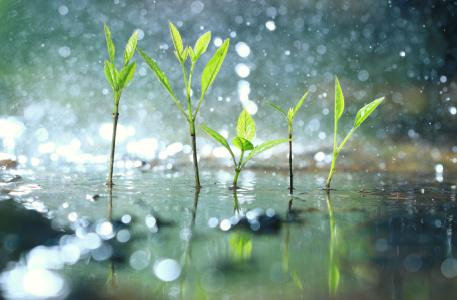
7 Ways to Trim Your Watering Bill and Help Your Yard Survive Drought Conditions
Summer is gardening and growing season—a time to get outside and enjoy your yard! But if there’s too much heat and not enough rain, the summer season can be hard on your plants and wallet.
There are many ways to reduce your yard’s reliance on water. Here are seven water- and money-saving options.
1. Eliminate evaporation.
Any time it rains—or when you manually water your plants—you want as much water as possible soaking into the soil instead of running off your property or evaporating into the atmosphere.
Water that lands on hard surfaces evaporates more quickly than on porous surfaces. So you can help water reach your plants’ roots and keep the soil moist longer if you apply a thick layer of mulch. Mulch also makes it harder for water-sucking weeds to appear.
Similarly, your plants will retain more moisture with a drip irrigation system (under the mulch) instead of sprinklers. If you must spray your lawn, you’ll reduce the amount of water lost to evaporation if you operate sprinklers in the evening instead of during the day.
2. Capture and reuse water.
Additional ways to maximize water use include recycling your laundry and shower water with a greywater system or collecting the rain on your roof. Rainwater harvesting is allowed or encouraged in most of the U.S., but some states and communities impose restrictions.
During heavy downpours, does part of your property collect too much water? If so, a rain garden might be an effective and eco-friendly way to eliminate significant puddles and put rainwater to good use.
3. Pick appropriate plants.
Some plants withstand dry conditions better than others. Generally, native plants are well adapted to your local climate, so you may want to select native grasses, flowers, trees, and shrubs specific to your zip code.
If you’re particularly concerned about drought conditions, focus on plants that require less water, like succulents and cacti.
4. Use suitable mulch.
Organic mulches like shredded wood may be plentiful in your area, which makes them a cost-effective, local solution. Plus, decaying organic matter helps enrich your soil.
However, organic mulches may retain too much moisture and promote the growth of mold, which can threaten drought-resistant plants, in particular. Therefore, stone or gravel mulch may be preferable.
5. Leverage shade.
Trees with an open, spreading canopy are a gift to gardeners in dry, sunny climates, providing opportunities to protect plants from scorching sunshine while allowing rain to fall through the branches.
Likewise, container plants may be ideally positioned under a canopy or awning, sharing the shade with your patio seating.
6. Establish watering priorities.
During brief dry spells, containerized plants are most vulnerable to damage. So ensure they receive enough water to stay alive, especially if you’re traveling.
However, shifting your priorities is essential during extended dry spells or a multi-year drought. Put your trees at the top of your list since they can contribute significantly to the value of your property and provide valuable shade and other environmental benefits.
Any prized perennials and attractive, well-established shrubs are your next priority. If you must ignore anything, make it your lawn.
7. Trade your turf?
Lush lawns are many homeowners’ dreams. However, grass turf can be challenging to maintain and expensive. Many communities have imposed watering restrictions, and some have outlawed lawns.
Consider trading some or all of your sod for other alternatives. Depending on where you live, your options may include large swaths of stone or organic mulch, a fake lawn, or a native prairie.
